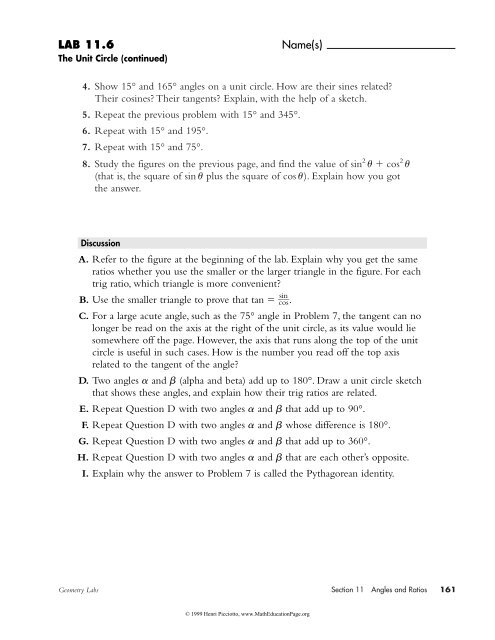- Page 1:
GEOMETRY Henri Picciotto LABS ACTIV
- Page 4 and 5:
Project Editor: Editorial Assistant
- Page 7 and 8:
Contents Introduction .............
- Page 9 and 10:
9 Distance and Square Root ........
- Page 11 and 12:
Introduction About This Book This b
- Page 13 and 14:
• Manipulatives can motivate stud
- Page 15 and 16:
If you have access to computers, I
- Page 17 and 18:
1 Angles An essential foundation of
- Page 19 and 20:
LAB 1.1 Angles Around a Point Name(
- Page 21 and 22:
LAB 1.2 Angle Measurement (continue
- Page 23 and 24:
LAB 1.4 Angles of Pattern Block Pol
- Page 25 and 26:
LAB 1.5 Angles in a Triangle Name(s
- Page 27 and 28:
LAB 1.6 The Exterior Angle Theorem
- Page 29 and 30:
LAB 1.6 The Exterior Angle Theorem
- Page 31 and 32:
LAB 1.7 Angles and Triangles in a C
- Page 33 and 34:
LAB 1.8 The Intercepted Arc (contin
- Page 35 and 36:
LAB 1.10 Soccer Angles Name(s) Equi
- Page 37 and 38:
LAB 1.10 Soccer Angles (continued)
- Page 39 and 40:
LAB 1.10 Soccer Angles (continued)
- Page 41 and 42:
2 Tangrams Tangram puzzles are quit
- Page 43 and 44:
LAB 2.1 Meet the Tangrams (continue
- Page 45 and 46:
LAB 2.2 Tangram Measurements (conti
- Page 47 and 48:
LAB 2.4 Symmetric Polygons Name(s)
- Page 49 and 50:
3 Polygons In the first two labs, t
- Page 51 and 52:
LAB 3.1 Triangles from Sides (conti
- Page 53 and 54:
LAB 3.2 Triangles from Angles (cont
- Page 55 and 56:
LAB 3.3 Walking Convex Polygons (co
- Page 57 and 58:
LAB 3.4 Regular Polygons and Stars
- Page 59 and 60:
LAB 3.5 Walking Regular Polygons (c
- Page 61 and 62:
LAB 3.6 Walking Nonconvex Polygons
- Page 63 and 64:
LAB 3.8 Sum of the Angles in a Poly
- Page 65 and 66:
LAB 3.9 Triangulating Polygons (con
- Page 67 and 68:
4 Polyominoes Polyominoes are a maj
- Page 69 and 70:
LAB 4.1 Finding the Polyominoes Nam
- Page 71 and 72:
LAB 4.2 Polyominoes and Symmetry Na
- Page 73 and 74:
LAB 4.3 Polyomino Puzzles Name(s) E
- Page 75 and 76:
LAB 4.4 Family Trees (continued) Na
- Page 77 and 78:
LAB 4.5 Envelopes (continued) Name(
- Page 79 and 80:
LAB 4.7 Minimum Covers Name(s) Equi
- Page 81 and 82:
LAB 4.9 Polytans Name(s) Equipment:
- Page 83 and 84:
LAB 4.10 Polyrectangles (continued)
- Page 85 and 86:
5 Symmetry Many of the activities i
- Page 87 and 88:
LAB 5.1 Introduction to Symmetry (c
- Page 89 and 90:
LAB 5.2 Triangle and Quadrilateral
- Page 91 and 92:
LAB 5.3 One Mirror Name(s) Equipmen
- Page 93 and 94:
LAB 5.4 Two Mirrors Name(s) Equipme
- Page 95 and 96:
LAB 5.4 Two Mirrors (continued) Nam
- Page 97 and 98:
LAB 5.5 Rotation Symmetry (continue
- Page 99 and 100:
LAB 5.6 Rotation and Line Symmetry
- Page 101 and 102:
LAB 5.7 Two Intersecting Lines of S
- Page 103 and 104:
LAB 5.8 Parallel Lines of Symmetry
- Page 105 and 106:
Triangles and 6Quadrilaterals The c
- Page 107 and 108:
LAB 6.1 Noncongruent Triangles (con
- Page 109 and 110:
LAB 6.2 Walking Parallelograms (con
- Page 111 and 112:
LAB 6.4 Making Quadrilaterals from
- Page 113 and 114:
7 Tiling In this section, we addres
- Page 115 and 116:
LAB 7.1 Tiling with Polyominoes Nam
- Page 117 and 118:
LAB 7.2 Tiling with Pattern Blocks
- Page 119 and 120:
LAB 7.4 Tiling with Regular Polygon
- Page 121 and 122:
8 Perimeter and Area This section s
- Page 123 and 124:
LAB 8.1 Polyomino Perimeter and Are
- Page 125 and 126: LAB 8.2 Minimizing Perimeter Name(s
- Page 127 and 128: LAB 8.3 A Formula for Polyomino Per
- Page 129 and 130: LAB 8.4 Geoboard Area Name(s) Equip
- Page 131 and 132: LAB 8.5 Geoboard Squares Name(s) Eq
- Page 133 and 134: LAB 8.6 Pick’s Formula (continued
- Page 135 and 136: Distance and 9Square Root This chap
- Page 137 and 138: LAB 9.1 Taxicab Versus Euclidean Di
- Page 139 and 140: LAB 9.2 The Pythagorean Theorem Nam
- Page 141 and 142: LAB 9.3 Simplifying Radicals Name(s
- Page 143 and 144: LAB 9.4 Distance from the Origin Na
- Page 145 and 146: LAB 9.6 Taxicab Geometry Name(s) Eq
- Page 147 and 148: 10 Similarity and Scaling Similarit
- Page 149 and 150: LAB 10.1 Scaling on the Geoboard Na
- Page 151 and 152: LAB 10.2 Similar Rectangles Name(s)
- Page 153 and 154: LAB 10.3 Polyomino Blowups Name(s)
- Page 155 and 156: LAB 10.3 Polyomino Blowups (continu
- Page 157 and 158: LAB 10.5 3-D Blowups Name(s) Equipm
- Page 159 and 160: LAB 10.6 Tangram Similarity Name(s)
- Page 161 and 162: LAB 10.7 Famous Right Triangles Nam
- Page 163 and 164: 11 Angles and Ratios This section p
- Page 165 and 166: LAB 11.1 Angles and Slopes Name(s)
- Page 167 and 168: LAB 11.2 Using Slope Angles Name(s)
- Page 169 and 170: LAB 11.3 Solving Right Triangles Na
- Page 171 and 172: LAB 11.4 Ratios Involving the Hypot
- Page 173 and 174: LAB 11.5 Using the Hypotenuse Ratio
- Page 175: Trigonometry Reference Sheet The pa
- Page 179 and 180: LAB 11.7 Name(s) Perimeters and Are
- Page 181 and 182: LAB 11.8 “” for Regular Polygon
- Page 183 and 184: 1 Angles Lab 1.1: Angles Around a P
- Page 185 and 186: For this pattern block hexagon, add
- Page 187 and 188: Theorems: triangle sum theorem, iso
- Page 189 and 190: Answers 1-5. See student work. 6. T
- Page 191 and 192: 7. Answers will vary. Discussion An
- Page 193 and 194: compass and straightedge.You may al
- Page 195 and 196: 3. Answers will vary. Here are some
- Page 197 and 198: which Question B hints at, is that
- Page 199 and 200: To make an algebra connection, you
- Page 201 and 202: Answers 1. See Polyomino Names Refe
- Page 203 and 204: Answers 1. C. F, N, P D. Only the W
- Page 205 and 206: Lab 4.7: Minimum Covers This lab is
- Page 207 and 208: 5. Discussion Answers A. Polyominoe
- Page 209 and 210: information in the relevant cells o
- Page 211 and 212: Discussion Answers A. Pentagons and
- Page 213 and 214: other. Students can make rubber sta
- Page 215 and 216: draw the lines and duplicate them y
- Page 217 and 218: 5. Answers will vary. Here are some
- Page 219 and 220: Or students could analyze: • poss
- Page 221 and 222: For Problem 2, make sure the studen
- Page 223 and 224: 2 hexagons, 2 triangles 1 hexagon,
- Page 225 and 226: 4. P max 2A 2 5. Answers will vary.
- Page 227 and 228:
This shows that 2 A⎤ 2n, and sinc
- Page 229 and 230:
Lab 8.5: Geoboard Squares Prerequis
- Page 231 and 232:
Answers 1. a. 11 b. 10 c. 4 d. 6.4
- Page 233 and 234:
3. Discussion Answers A. √5 5 √
- Page 235 and 236:
If your students enjoy Problem 6, a
- Page 237 and 238:
4. a. 5. a. (0, 0) (6, 0) (0, 0) (0
- Page 239 and 240:
congruent to each other and similar
- Page 241 and 242:
2. (In the Perimeter table, numbers
- Page 243 and 244:
Discussion Answers A. They are the
- Page 245 and 246:
Discussion Answers A. Each individu
- Page 247 and 248:
3. Triangle c: 1, 3, 2 4. Triangles
- Page 249 and 250:
type of slope triangle will work fo
- Page 251 and 252:
Discussion Answers A. Answers will
- Page 253 and 254:
8. sin 2 cos 2 1. It is the Pythago
- Page 255 and 256:
Geometry Labs Geoboard Paper 239 ©
- Page 257 and 258:
Geometry Labs 1-Centimeter Grid Pap
- Page 259 and 260:
Geometry Labs Circle Geoboard Paper
- Page 261 and 262:
To make the radius of this circle e
- Page 263 and 264:
Geometry Labs Unit Circles 247 © 1
- Page 266:
GEOMETRY LABS Geometry Labs are han






